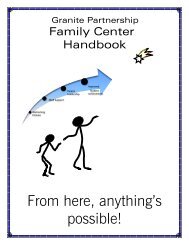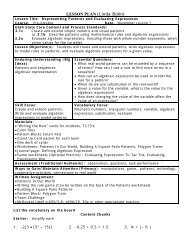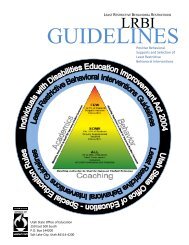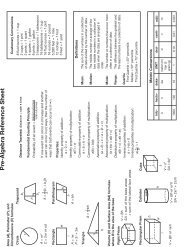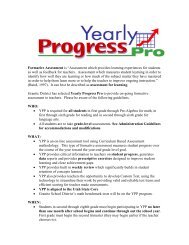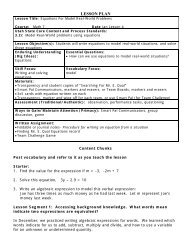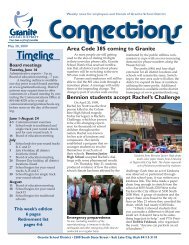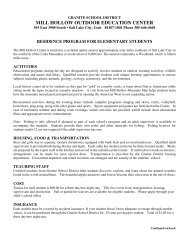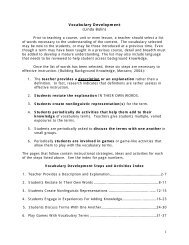LESSON PLAN (Linda Bolin) - Granite School District
LESSON PLAN (Linda Bolin) - Granite School District
LESSON PLAN (Linda Bolin) - Granite School District
You also want an ePaper? Increase the reach of your titles
YUMPU automatically turns print PDFs into web optimized ePapers that Google loves.
<strong>LESSON</strong> <strong>PLAN</strong> (<strong>Linda</strong> <strong>Bolin</strong>)<br />
Lesson Title: Angles, Triangles, Quadrilaterals, Circles and Related Vocabulary<br />
Course: Pre-Algebra Date : January Lesson 2<br />
Utah State Core Content and Process Standards:<br />
Review identifying rectangles, triangles, angles, and sides<br />
Lesson Objective(s): Use two-dimensional shape vocabulary to identify attributes of<br />
Triangles and Quadrilaterals<br />
Enduring Understanding (Big<br />
Ideas):<br />
Triangles and Quadrilaterals have<br />
identifying attributes<br />
Essential Questions:<br />
• What vocabulary is associated with Triangles,<br />
Rectangles and Circles<br />
• How can we use angle measures to compare<br />
angles?<br />
• How can length of sides and measure of angles be<br />
used to classify triangles and quadrilaterals?<br />
Skill Focus:<br />
Recognize attributes of triangles and<br />
quadrilaterals, and use vocabulary<br />
related to two-dimensional figures<br />
Vocabulary Focus:<br />
Angle, side, right, acute, obtuse, equilateral, isosceles,<br />
scalene, parallelogram, square, rectangle, rhombus,<br />
trapezoid, base, congruent , circle, radius, diameter,<br />
circumference<br />
Materials:<br />
Geometry Vocabulary Sort paper for each team<br />
Foldable: Two-dimensional Vocabulary<br />
Song overhead<br />
Two-Color Paper Plate manipulative<br />
CD player and CD<br />
Worksheets: Triangle Classification, Sorting Quadrilateral<br />
Assessment (Traditional/Authentic): student physical and oral response. Performance<br />
task<br />
Ways to Gain/Maintain Attention (Primacy): music, movement, drama (role playing),<br />
sketching, team work<br />
Written Assignment:<br />
• Journal: Two-dimensional Words<br />
• Worksheets: Classifying Triangles, Quadrilateral Sort<br />
Post all vocabulary<br />
Content Chunks<br />
Starter:<br />
Check your memory: sketch an example for each:<br />
1. two parallel lines<br />
2. two perpendicular lines<br />
3. an acute angle<br />
4. an obtuse angle<br />
5. a ray<br />
6. a line segment<br />
7. the diameter of a circle<br />
These are a review of geometric ideas learned over the past several years.
Lesson Segment 1: What vocabulary is associated with Triangles, Rectangles<br />
and Circles<br />
In teams, students should work together to do the vocabulary sorting activity. Discuss<br />
with the class the categories they chose for their vocabulary sorts.<br />
Review basic vocabulary by having student teams discuss and complete the Twodimensional<br />
Geometry Words Foldable for their journals. As they fill in each word,<br />
have them do a round robin to show their team what they have sketched and written.<br />
Discuss as a class to make sure students include vocabulary for all essential attributes<br />
and parts.<br />
Lesson Segment 2: How can we use angle measures to compare angles?<br />
Sing the Angle Measures Song.<br />
Classifying Angles Song<br />
(to the of Skip To My Lou. Lyrics by <strong>Linda</strong> <strong>Bolin</strong>)<br />
Use arms to show each as the verse is sung.<br />
I’m a little angle. I like me like that.<br />
An ACUTE little angle, and I’m not fat.<br />
I’m an alligators mouth or a witches hat.<br />
I’m ACUTE. I’m less than 90.<br />
I’m a RIGHT angle, and I look square.<br />
Look for a corner, and I’ll be there.<br />
I’m a flag or a present. I’m everywhere.<br />
I’m just RIGHT. I’m exactly 90.<br />
I’m rather large, so I have pride.<br />
I’m an OBTUSE angle. I’m big inside.<br />
I’m a reclining chair or a door open wide.<br />
I’m OBTUSE. I am more than 90.
Give each pair of students a Two-Colored-Plates manipulative (two different<br />
colored small plastic plates that have been slit to the center and slid inside each other<br />
to make rotating sections. Call out categories such as acute, right, and obtuse having<br />
student pairs form these with the Two-colored Plates manipulative. You may also want<br />
to ask them to estimate common angle measures such as 45°, 90°, 120°, and 350°<br />
and angle measures and have students make and show a good estimate example on<br />
the plates. This would be a good exercise in using the classifying to compare angles.<br />
Lesson Segment 3: How can length of sides and measure of angles be used to<br />
classify triangles and quadrilaterals?<br />
Give students the Classifying Triangles worksheet to guide them in looking at<br />
attributes of triangles and in using related vocabulary. As student write on their paper,<br />
describe and model the meaning of the words explaining the attributes for each<br />
category. Music: Put on a CD with some good music. Tell students they will be doing<br />
the Triangle Dance. They stand and use their arms and bodies to form the meaning of<br />
the words as you call out, “Equilateral”, “Scalene”, “Isosceles”, “Right”, “Acute”, and<br />
“Obtuse”. You can assess their understanding as they move to the music while you say<br />
the various attributes.<br />
Give student pairs the Quadrilateral Shapes paper that has the various<br />
quadrilaterals on it. Have them look at each quadrilateral, discuss what they notice<br />
about the angle types, then what they notices about the sides being parallel or<br />
congruent. Then, have the pairs work together to complete the Quadrilateral Sort<br />
worksheet and be ready to discuss their rules for the sorts with the class. Have them<br />
label each shape on the Quadrilateral Shapes paper to refer to in the next activity.<br />
Practice and summary:<br />
Guess The Fib Game<br />
Student pairs work together to choose one of the ideas or vocabulary discussed<br />
in class in this lesson. They should write two true statements about that idea and one<br />
fib about that idea. Once the pairs have their three statements written, a pair reads<br />
their three statements to the class and gives teams a chance to discuss, then call on a<br />
person to “Guess their Fib”.
Geometry Vocabulary Sorting<br />
1. Sort these words into three categories: Words I know, Words I have heard<br />
before, but am not confident about, Words I don’t even recognize<br />
2. Take the words you are confident about-words you know, and sort them<br />
now into three or more categories. Write the rule for placing a word into each<br />
of the categories you choose. Categories must be based on meaning of the<br />
word, not on things like short words and long words.<br />
Triangle Length Circumference Radius<br />
Width Quadrilateral Square Acute<br />
Two-dimensional<br />
Parallelogram Height Base<br />
Rectangle Pentagon Obtuse Octagon<br />
Circle Right Face Diameter<br />
Hexagon Angle Congruent Parallel<br />
Perpendicular<br />
Intersecting Line Vertex
Word Examples Attributes<br />
And Parts<br />
Point<br />
Line<br />
Parallel<br />
Perpendicular<br />
Angle<br />
Polygon<br />
Triangle<br />
Quadrilateral<br />
Circle
Triangle Classification<br />
Name ____________________<br />
Angles<br />
Triangles<br />
Sides<br />
Right<br />
Acute<br />
Equilateral<br />
Scalene<br />
Isoceles<br />
Obtuse<br />
1. Explain we mean when we say a triangle is Right? Sketch two examples.<br />
2. Explain we mean when we say a triangle is Obtuse? Sketch two examples.<br />
3. Explain we mean when we say a triangle is Acute? Sketch two examples.<br />
4. Explain we mean when we say a triangle is Isosceles? Sketch two examples.<br />
5. Explain we mean when we say a triangle is Scalene? Sketch two examples.<br />
6. Explain we mean when we say a triangle is Equilateral? Sketch two examples.
Sorting Quadrilaterals<br />
Name__________________<br />
Cut out the quadrilaterals. Look carefully at the characteristics such as<br />
angle measurement, length of the sides, whether sides are congruent,<br />
whether angles are congruent, whether opposite sides are parallel.<br />
1. Sort the quadrilaterals into two categories according to the characteristics<br />
above. Do not sort them according to size. Write the rules for the two<br />
categories.<br />
First Sort<br />
Category Which quadrilaterals<br />
belong in this<br />
Category?<br />
What characteristics do these<br />
quadrilaterals have in common?<br />
1<br />
2<br />
2. Sort the quadrilaterals into three categories according to their characteristics.<br />
Write the rules for the categories.<br />
Second sort<br />
Category Which quadrilaterals<br />
belong in this<br />
Category?<br />
What characteristics do these<br />
quadrilaterals have in common?<br />
1<br />
2<br />
3
Quadrilateral Shapes<br />
1<br />
2<br />
3<br />
4<br />
5<br />
6<br />
7<br />
8<br />
9




